
GULF COAST ELECTRIC COOPERATIVE
FEBRUARY 2024


Families flock to raise backyard chickens
Page 12















GULF COAST ELECTRIC COOPERATIVE
FEBRUARY 2024


Families flock to raise backyard chickens
Page 12













February 2024 • Volume 13, No. 4
CEO Michael Shepard
VICE PRESIDENT OF CONTENT Leon Espinoza
EDITORIAL DIRECTOR Mike Teegarden, CCC
DEPUTY EDITORIAL DIRECTOR
Noble Sprayberry
SENIOR EDITOR Jennifer Paton, CCC
FLORIDA CURRENTS EDITORS
Chasity Anderson, CCC; Valeri Pearon
ASSISTANT EDITORS Victoria Hampton, CCC; David Herder, CCC
ASSOCIATE EDITOR
Nina Todea
PUBLICATIONS PRODUCTION
SENIOR MANAGER
Elizabeth Beatty
PUBLICATIONS COORDINATOR
Alyssa McDougle
Members acknowledge that $4.31 a year, plus postage, is the cost to publish 12 issues a year of FLORIDA CURRENTS ISSN 23276304 (USPS 8300). Published by Pioneer Utility Resources Inc., 5625 NE Elam Young Pkwy. Ste. 100, Hillsboro, OR 97124—a not-for-profit Oregon cooperative corporation—the magazine serves the communication needs of consumerowned electric utilities in Florida. Preferred Periodicals postage paid at Hillsboro, OR 97123 and at additional mailing offices.
Postmaster: Send address changes to 5625 NE Elam Young Pkwy., Ste. 100, Hillsboro, OR 97124-6422.
HOW TO CONTACT FLORIDA CURRENTS
Subscription services:
Nonmember subscriptions $15 U.S. a year; $25 foreign a year. Prepayment required. Allow 4-8 weeks for first issue. Identify local edition desired. Have a problem receiving your magazine? Utility members should contact their utility office. Nonmembers call 503-357-2105 or email mailingdept@pioneer.coop.
Back issues:
Back issues and extra copies are $3 each, prepayment required. Supply is limited. Identify edition, month and year. Call first to check availability. Contact Pioneer Utility Resources: P.O. Box 1306, North Plains, OR 97133-1306; 503-357-2105; email: mailingdept@pioneer.coop.
DISPLAY ADVERTISING INQUIRIES
American MainStreet Publications 611 S. Congress Ave. Ste. 504 Austin, TX 78704-1714; 800-626-1181 or 512-441-5200; amp.coop.
© 2024 Pioneer Utility Resources. All rights reserved. Reproduction in whole or in part without written permission is prohibited. Direct reprint requests to editor@floridacurrents.com or for more information, visit www.pioneer.coop.


additional content, search





Always here for you
As your hometown utility, Gulf Coast Electric Cooperative is locally owned by those we serve. We improve quality of life by safely providing affordable and reliable power. We also promote job development and support education and health care. In doing so, we help our communities and the people we serve—our member-owners.
It’s another way your hometown electric cooperative is always here for you.
|







Teresa Barfield, Cole Barfield and Colby Wiggins earn special employee recognition
Three Gulf Coast Electric Cooperative employees received special awards named in memory and honor of former employees, and several others were recognized for service anniversaries at a December 13 gathering.
Alfredia Owens Member Service Award
Teresa Barfield was presented with the Alfredia Owens Member Service Award.
The award recognizes an employee who demonstrates high-quality service to members; gets along well with fellow employees; demonstrates empathy and compassion to members; demonstrates integrity and honesty; keeps members,

the general public and employees safe; and serves as a role model to others through positive interactions.
Tony “T-Bone” Turner Hustle Award
Cole Barfield was presented with the Tony “T-Bone” Turner Hustle Award.
Cole was honored for his sustained work and productivity record; exceptional efficiency; superior performance and dedication; keeping members, the general public and employees safe; and serving as a role model to others through positive interactions.
Tomica Lowery Memorial Award
Colby Wiggins was presented with the Tomica Lowery Memorial Award.
The award recognizes an employee who exemplifies appreciation for fundamental human needs of fellow employees; clear communication with coworkers; and increasing organizational commitment demonstrated by employee satisfaction,
enjoyment at work and lowering negative efforts leading to lower absenteeism and stress.
Service Pins Awarded Service pins were awarded to 33 employees and trustees who have a total of 320 years of service to Gulf Coast members.
Recipients included Pat Floyd and Timmy Wade, 35 years; Randy Mayhann and Tony Morrell, 30 years; Mary Cook, 25 years; Brennis Smith, 20 years; Doug Birmingham, Jimmy Black, Will Coatney and Daisy Shewman, 15 years; Cole Barfield, John Bartley, Chad Creamer, Jamey Guffey, Betty Moore and Mike Waites, 10 years; Teresa Chase and Colby Wiggins, 5 years; and Teresa Barfield, Tucker Barfield, Montana Barnes, John Baxter, Mark Boon, Caleb Flippo, Chad Flowers, Logan Joyner, Tabitha Lee, Chase Lewis, Matt Rich, Logan Richard, Jarvest Sheffield, Dwight Van Lierop and Sheneka Williams, one year.

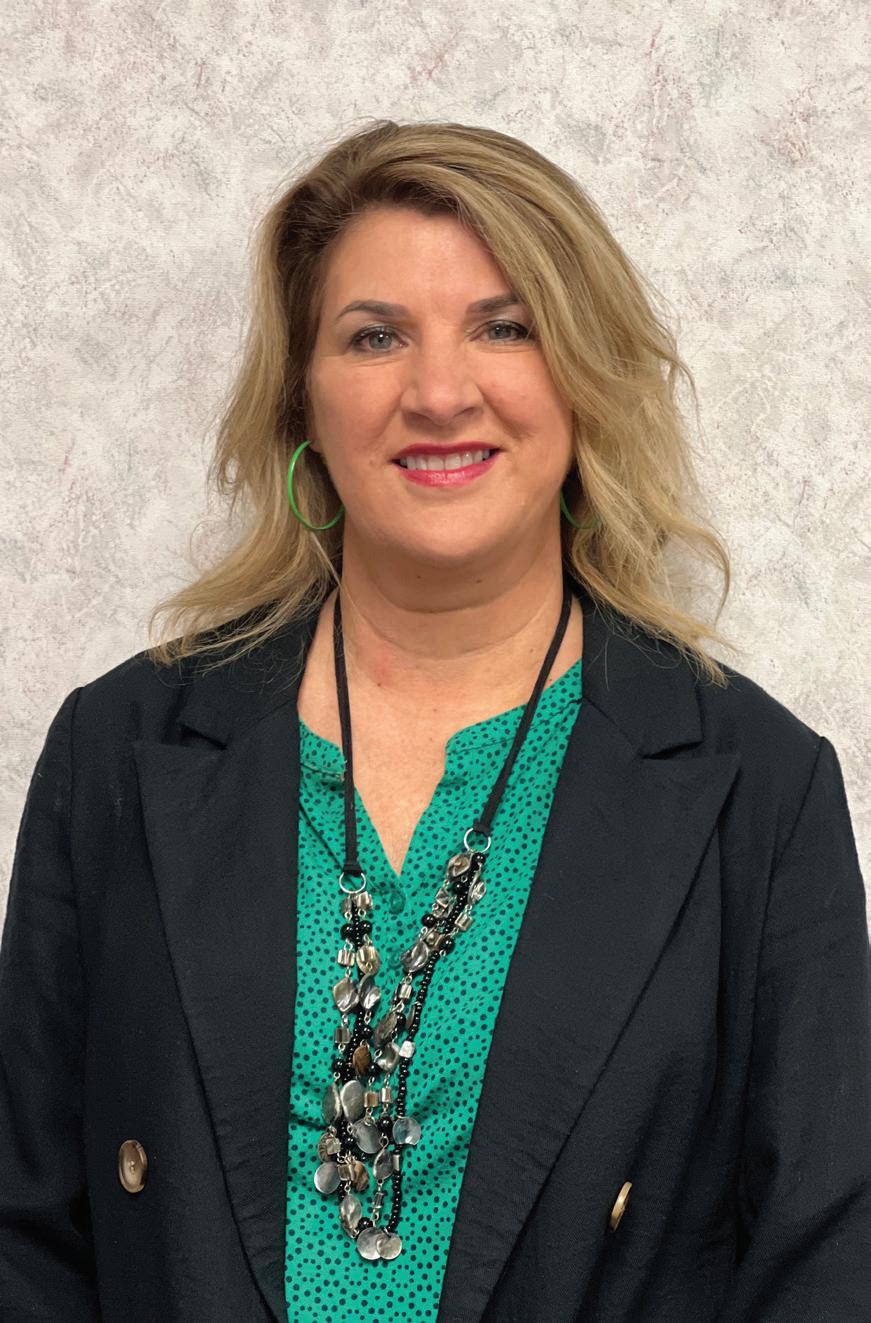


Three Gulf Coast Electric Cooperative employees earned special recognition by receiving awards in memory and honor of former employees.







For many years, Gulf Coast Electric Cooperative employees and trustees have incorporated a drive to benefit the Children’s Home Society into their annual Christmas party. This year was no exception. Employees and trustees graciously provided toys and other items to benefit local children in need. Presenting donations to the Children’s Home Society is Kristin Douglas, third from left, of the co-op.














GCEC had an entry in Blountstown’s lighted Christmas parade.





Gulf Coast Electric Cooperative sponsored Tyndall Air Force Base’s tree lighting ceremony. Approximately 200 people attended this annual event. The ceremony featured carolers from the base Child and Youth Center, hot chocolate, s’mores, cookies and “snow.” Santa arrived on the Tyndall Fire Department truck.











The 2023 ceremony was extra special because it was the first time the base had a tree since Hurricane Michael in 2018. The 18-foot tree was lit by 325th Fighter Wing Commander Col. George Watkins. Kristin Douglas, left, and Teresa Chase hand out light-up necklaces to attendees.



GCEC sponsored Breakfast with Santa at Tyndall Air Force Base. About 300 people attended the December event.



Mark your calendar for Saturday, April 27, and plan to attend Gulf Coast Electric Cooperative’s 76th Annual Members’ Meeting at the co-op headquarters in Wewahitchka.
In addition to hearing reports about your cooperative and electing directors, watch informational presentations—such as the co-op’s safety trailer—and have a chance to win prizes, all while enjoying good food and entertainment.
The meeting agenda reflects what keeps your electric cooperative in business serving the community. Your vote, voice and participation all go into making your cooperative a unique entity. The cooperative way of doing business is truly democracy in action.
Bring the family, meet and greet your neighbors and friends, and make your annual meeting a memorable moment. We look forward to seeing you there.
Jimmy Black represents members in the Green Hills-Fountain area. The district is bounded on the west side by the centerline of North Bay, Deer Point Lake and Econfina Creek, on the north and east by the Bay County line, and on the south by the township line dividing Township 2 South and Township 3 South.
Jimmy began serving on Gulf Coast Electric Cooperative’s Board of Trustees in 2008. He holds a bachelor’s degree in health and physical education from Texas A&M University and a master’s degree in public administration from Golden Gate University. He retired as a major with the U. S. Air Force in 1994 and was employed by Bay District Schools as a teacher until his retirement in May 2023.
In 2009, Jimmy earned his National Rural Electric Cooperative Association Credentialed Cooperative Director Certification, and in 2016, he obtained his Board Leadership Certification. In 2018, Jimmy earned and continues to maintain his Director Gold Credential. He currently serves as president of the GCEC Board of Trustees and has also served as vice president.
Jimmy and his wife, Lorie, have three children and three grandchildren. In his spare time, Jimmie enjoys sports, farming and being with his family. He attends City Church of Northside.



As Gulf Coast Electric Cooperative celebrates its 76th Annual Members’ Meeting, it also is time to elect your representatives.
According to the bylaws, the board must name the Nominating Committee at least 90 days before the meeting.
The Nominating Committee must meet and nominate candidates for open trustee positions at least 60 days before the annual meeting.
Those not selected by the Nominating Committee—but who are interested in serving—have until February 29 to present a nomination by petition to have their names on the ballot. A petition needs the signature of at least 25 cooperative members.
District III trustees are up for election this year. The incumbents are Rupert Brown, Jimmy Black and Robert Byrd.
The 76th Annual Members’ Meeting is Saturday, April 27.
Copies of the bylaws and the nominating procedures are available in GCEC’s main office in Wewahitchka and district offices in Panama City and Southport.
You also may view the cooperative’s bylaws at www.gcec.com.


— Darlene & Jack B., CA A Better Way to hearTV®
“Now Jack can control the volume on his TV•Ears while I set the TV volume or mute it for complete quiet. Once again, he can understand every word and we can watch our favorite TV shows together.”

Doctor recommended TV•Ears powerful assistive listening device has helped millions of people enjoy their favorite television shows, movies, and streaming content without disturbing others.
Voice Clarifying Audio® works better than hearing aids for watching TV as it eliminates background noise and boosts hard to hear television dialog making voices, whispers, and accents understandable.
120db of volume provides extra power not found in hearing aids or regular TV headphones. Hear as loud as you want on the headset while others listen at a comfortable volume.

















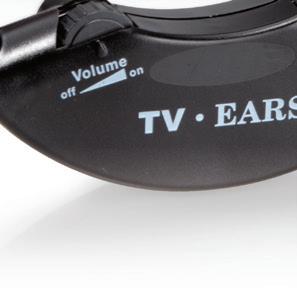




With steady hands, Fred Bassett gently clamps a tiny, lightweight metal band with identification numbers above a hummingbird’s foot.


By Dianna Troyer





home state of Alabama and travels throughout the Southeast, especially Florida.
As he gently handles the high-energy bird, it becomes subdued.

“I never get tired of doing this,” he says, talking to appreciative observers in the shady yard of a rural home in Southeastern Idaho. They watch him weigh and measure the length of a male, black-chinned hummingbird.


“It’s not like doing this is any kind of hardship,” says Fred, 77, a certified master bird bander. He is among only 125 people nationwide with a master banding permit issued by the Bird

Bird
Banding Laboratory through the U.S. Geological Survey.


“You can feel their heartbeat—about 600 beats a minute when they’re calm and 1,200 beats when they’re exerting themselves,” he says, gently depositing the bird in the outstretched palm of an awestruck onlooker.
“If your heart does that, you’d be in a heap o’ trouble,” Fred says, laughing. The bird seems to be napping, his iridescent plumage hypnotizing observers. Eventually, he zooms away.

During winter, Fred

is based in his








After retiring as an Air Force pilot, Fred discovered a new calling when friends taught him to band hummingbirds. Since 1997, he has made it his mission to band the diminutive birds, teach others how to do it and educate observers wherever he travels. He has banded more than 35,000 hummingbirds at 1,400 locations in 17 states.
Fred notes each bird’s species, gender, length, weight and band number. The information goes into the Bird Banding Laboratory’s database. Generally, North American hummingbirds weigh 0.1 to 0.2 ounces and are 3 to 4 inches long with a wingspan of about 3 to 4 inches.
To share what he’s learned, Fred founded hummingbirdresearch.net and has posted videos titled “Hummingbirds with Fred Bassett” on YouTube.





“You’re the lucky ones out here in the West because you routinely see broadtailed, calliope, black-chinned and rufous,” he says. “Back East, the ruby-throated hummingbird is dominant.”
Generally, Fred bands about 70 to 80 birds daily, with several returning in the same day.
“If you want to put up a feeder, remember it’s one part sugar to four parts water and no honey or red food coloring,” he says.
At the Southeastern Idaho home in midsummer, the tiny birds with voracious appetites gobble nearly 3 gallons of sugar water daily at 10 one-quart feeders hung throughout the yard. By late July, young birds have fledged.
Sometimes, more than 100 birds dive and hover every evening. To satisfy their seemingly insatiable hunger, the homeowners buy 250 pounds of sugar from spring to fall. The feeders are left up through October because some stragglers are still migrating.

As he bands the birds, Fred describes their remarkable lives. After building a nest of soft plant fibers, twigs and fresh spiderwebs, a female often shingles the exterior with tiny bits of leaves. Her two eggs, each about the size of a Tic Tac,

the characteristic humming sound.
“Their shoulders rotate 360 degrees, so they can hover and fly any direction— even backward,” Fred says. “They make pilots jealous.”
Remarkable Stamina
Hummingbirds are speedy fliers, zooming up to 37 mph and up to 60 mph in courtship dives. The ruby-throated hummingbird often doubles its weight and migrates alone, flying nonstop 600 miles across the Gulf of Mexico in 18 to 24 hours, depending on the weather.

After banding, Fred gently deposits the bird in an appreciative birdwatcher’s palm.
says. “I tell them they can believe whatever
“People tell me that’s impossible,” Fred
some record-setting birds defy those odds and live as long as 13 years, according to information at hummingbirdresearch.net.
Eventually, new technology may supplement the bands, Fred says. A lightweight battery-powered tracking device is being developed for the birds to wear, enabling researchers to pinpoint their daily movements and migration routes.

“Whenever that’s accomplished, we’ll have a heap of new insights and learn just how much we didn’t know,” he says, grinning.
More information is at Hummingbirds with Fred Bassett, Summer and Winter, on YouTube and at hummingbirdresearch.net.


In Lakeland, Florida, a male ruby-throated hummingbird Fred Bassett banded January 24, 2014, was located four years later in Canada. A bird bander found it May 27, 2018, in Utopia, New Brunswick—a trek of 1,700 miles. It was the first wintering ruby-throated hummingbird found at its breeding area.
A female rufous hummingbird set the record of 3,500 miles for banding and recapture—from Tallahassee, Florida, to Chenega Bay, Alaska. Fred Dietrich banded her January 13, 2010, in Florida. Five months later, June 28, 2010, she was found by fellow bander Kate McLaughlin in Alaska. Visit www.hummingbirdresearch.net under the hot news tab to learn more.
A male calliope hummingbird’s bright feathers attract females. PHOTO COURTESY OF FRED






By Jen Calhoun



For the Drake family, including Riley, owning chickens is a learning experience. The lessons include biology and how to tend to a bird with minor injuries. PHOTOS COURTESY OF BECKY AND JIM




Bobbi Drake was visiting with a friend when a chicken popped onto her friend’s lap. The sight made her laugh.
“I said, ‘Wow! These are fun chickens.’”
Her friend agreed.
“I’d rather have chickens than a dog or a cat,” the friend said. “They’re too much trouble. But these chickens? They’re great.”
Not long after, Bobbi and her husband, Rod, bought a few chicks for their backyard in Polk County. Now, Tillie, Millie and Lillie—a Plymouth Rock and two buff Orpingtons— live the good life along Lake Hatchineha. They, too, like to hop on laps for a cuddle.
As retirees, the couple have found their hens to be a good fit.
“I didn’t want a dog, and I didn’t want a cat,” Bobbi says. “They don’t shed in the house, and they don’t have to be potty-trained. I’d been there and done that, so I thought I’d try these chickens. I really enjoy them.”
It’s a familiar story for Osceola County Extension Agent Jessica Sullivan, who’s seen an increase in families keeping backyard chickens in recent years.
“Absolutely, people are treating them like pets,” she says with a laugh. “Just like a dog or a cat, people can get very attached to chickens. They spend a lot of time with them and even cuddle with them.”
Some even build or buy what Jessica likes to call boutique chicken coops.
“They’ll make them super cute and paint them really pretty,” she says. “Some people really have fun with it.”

Young chicks can do geometry. A study at the University of Trento in Italy found they can distinguish numbers and learn patterns in different sets of objects or sounds when looking for food. They can also recognize these patterns in the future. This means they might be able to understand complex relationships between objects or individuals.
A 2011 study at the University of Bristol in England found chickens can feel empathy.
Chickens can make dozens of sounds— at least 24—and mean different things. They might make a high-pitched “eeee” sound when a hawk circles. The clucking sound most people know is often used when encountering a predator.
Source: Scientific American, “The Startling Intelligence of the Common Chicken,” May 1, 2017




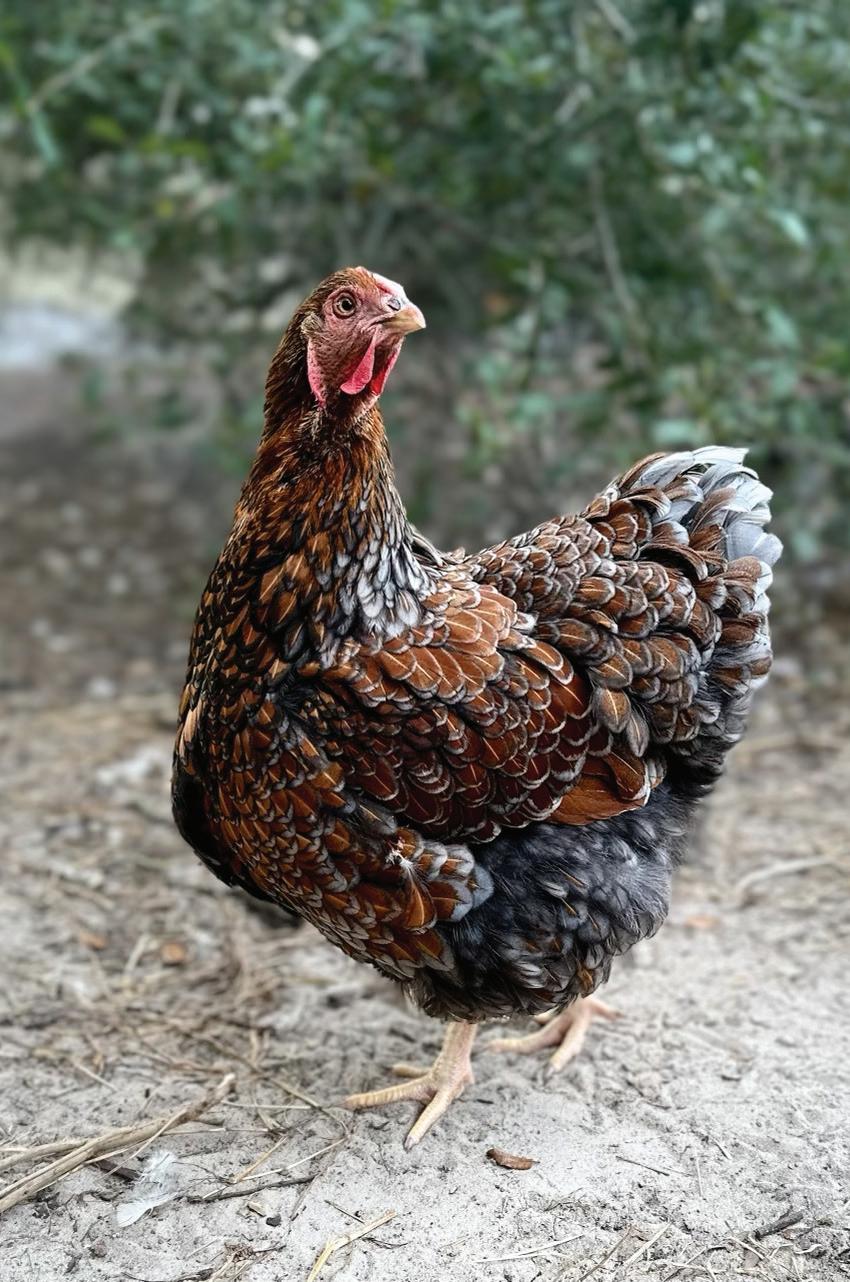
Keeping chickens as pets is the latest evolution of a trend that grew quickly around the time of the COVID-19 pandemic. Jessica noticed it when she started fielding calls from people with questions about raising bees and chickens and planting small gardens and orchards.
As the calls grew more frequent and the questions more varied, the former horticulture student found a niche for herself. Now, Jessica is the go-to person for anyone in the county interested in small farming and homesteading.
“Oftentimes, these are people who probably would prefer an acre or two, but they have maybe one-sixth of an acre lot in their backyard,” she says. “They want to maximize that.”
Many want the lifestyle that comes with raising chickens, too.
“A lot of times, the people I talk to are families that want fun and interesting things to do,” Jessica says. “They want to learn about where food comes from and teach their kids. They end up keeping small livestock like chickens and bees that produce safe food products. They also like gardening and planting little backyard orchards.”

Those were the very things that interested Becky Drake, Bobbi and Rod’s daughter. Becky bought her first chicks after she and her son, Riley, visited her parents’ house.
“Riley just loved them,” Becky says. “We were calling him the chicken whisperer because they were jumping all over him.”
Over the past two years, Becky and Riley have added ducks, quail and bees to their double lot in Sarasota County.
“The chickens were sort of a gateway drug,” Becky says with a laugh.
What’s really impressed her is watching her 12-year-old and his friends learn more about animals and biology.
“They’ve learned about genetics—recessive genes and dominant genes—because of crossing different-colored eggs with each other,” she says. “We’ve also learned some minor veterinary stuff when they’ve gotten injured.”
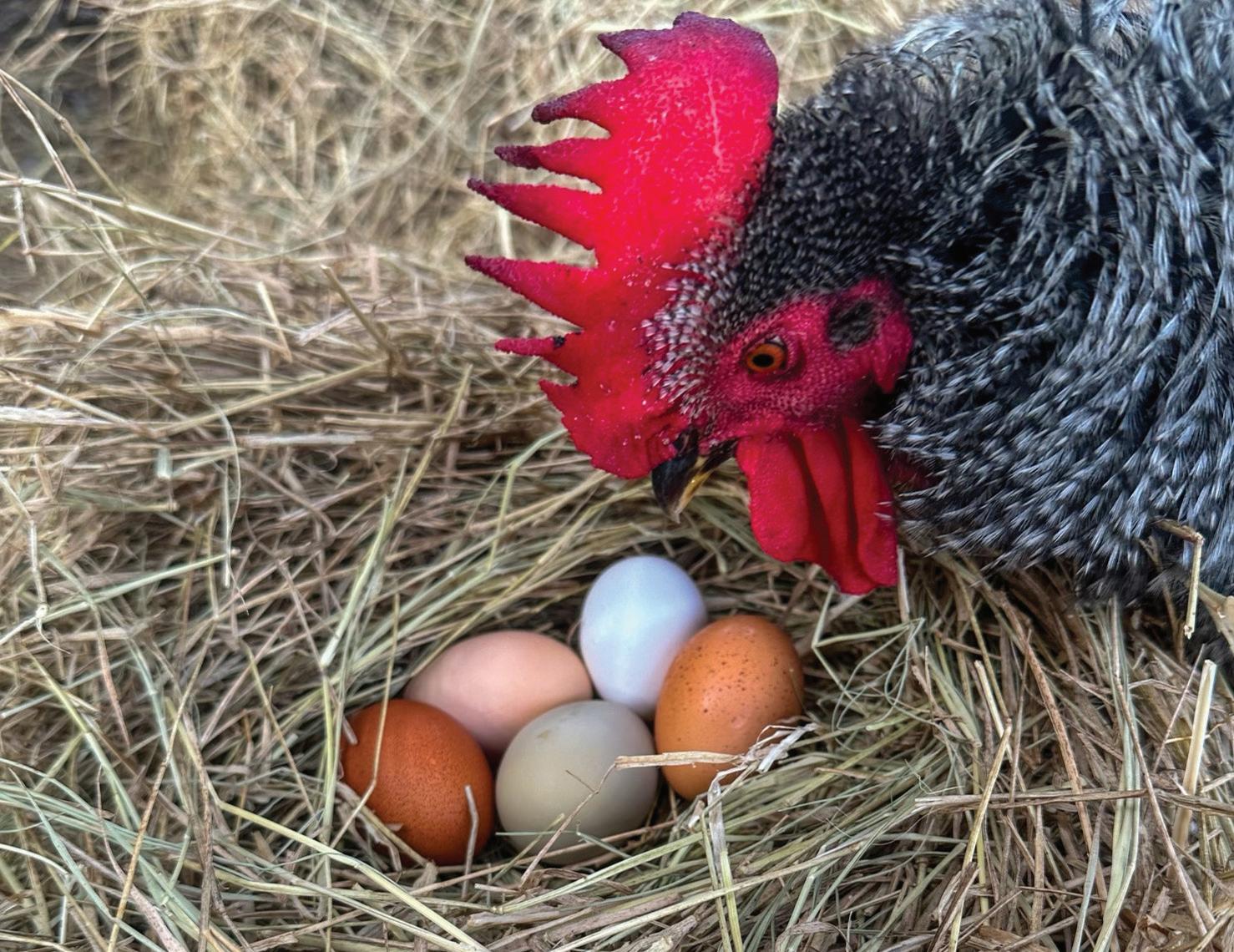


Fresh eggs are a plus, too. When there’s a surplus, Becky often gives them to co-workers and friends. She also likes to donate to people in need.
But the absolute best part about owning chickens is watching them live their day-to-day lives like a reality show, Becky says. She watches them seemingly argue with each other. Other times, they all pile on top of each other into one nesting box, even when several other boxes are available.
“They’re so funny,” she says. “I love to watch these chicken dramas play out.”
Tending your own chickens can be a funfilled, educational hobby. It’s also a great way to get eggs. But owning chickens is still a big responsibility. If you’re trying to decide if backyard chickens can work for you, consider these points before jumping headfirst into the chicken lifestyle.
Local laws and neighborhood regulations. Check for the latest rules on chicken ownership in your city and county. Do the same if you live in a neighborhood with a covenant or a homeowners association. Many cities limit the number of chickens allowed per household and prohibit roosters entirely. Often, cities require chickens to be kept enclosed and in well-maintained coops that are cleaned frequently. Don’t rely on hearsay or a neighbor’s knowledge. Check out the rules for yourself. One more thing: If you decide to sell your eggs, ensure it’s legal where you live. Many local and state governments have rules about selling foodstuffs.
Expenses. Keeping chickens isn’t cheap. Even small-scale chicken farming requires ongoing expenses after buying or building a coop and fencing. Consider that a 40-pound bag of feed can cost $25



and up, depending on the brand, nutritional value and other factors. That might last a handful of chickens a month or so, but it won’t always fulfill all their dietary needs. Extra proteins and treats, such as dried insects, can get pretty pricey too. Some cost up to $50 for a 5-pound bag. In addition, chickens require fresh bedding, such as pine shavings or chopped straw, every time the coop is cleaned.
Care. While caring for chickens isn’t a full-time job, you still need to spend some time doing it. Most people adopt a daily or twice-daily routine for feeding and watering. Many times, chickens need to be let out of a small coop in the morning and


herded back in at night for safety. These things are important to remember before you take a vacation. In addition, chickens can fly. Some people prefer to clip their wings regularly, while others choose a run with fencing or netting overhead.
While it’s not a pleasant thought, it’s important to remember that almost every carnivore and omnivore in the animal kingdom likes the taste of chicken. Chickens are susceptible to predators, such as hawks, foxes, raccoons, opossums, coyotes and even cats and dogs. They can also get sick, and there might not be a veterinarian in your area that accepts them.
















Minestrone
2 teaspoons olive oil
1 cup diced carrots
½ cup diced celery
½ cup chopped onion
4 garlic cloves, minced
32 ounces chicken broth
28-ounce can petite diced tomatoes
1 tablespoon tomato paste
15-ounce can white beans, drained and rinsed
15-ounce can red kidney beans, drained and rinsed
Parmesan cheese rind

½ teaspoon kosher salt
¼ teaspoon fresh black pepper
1 fresh rosemary sprig
2 bay leaves
2 tablespoons chopped fresh basil
¼ cup chopped fresh Italian parsley
1 medium zucchini, diced
2 cups baby spinach, chopped kale or chopped collard greens
Salt and pepper, to taste
Parmesan cheese and red pepper flakes for garnish
Heat oil in a large Dutch oven or pot over medium-high heat. Add the carrots, celery, onion and garlic. Stir. Saute until tender and fragrant, about 15 minutes.
Add broth, tomatoes, tomato paste, beans, cheese rind, salt, pepper, rosemary, bay leaves, basil and parsley. Bring to a boil. Cover. Cook on low for 40 minutes.

Remove the bay leaves, rosemary and Parmesan rind. If you prefer a thicker soup, pulse a few times with an immersion blender.
Add the zucchini and spinach. Cover. Simmer until the zucchini is tender, about 8 to 10 minutes. Season to taste with salt and black pepper. Garnish with Parmesan cheese and red pepper flakes.

16 ounces Italian sausage links, medium or hot
6 slices bacon
¾ cup chopped onion
1½ teaspoons minced garlic
2 tablespoons chicken soup base
1 quart water
Heat the oven to 300 F.
2 large potatoes, cut into ¼-inch slices
2 cups kale, washed, dried and shredded
1⁄3 cup heavy whipping cream
Parmesan cheese
Place sausage links on a sheet pan. Bake for 25 minutes or until cooked through. Cut links in half lengthwise, then cut at an angle into ½-inch slices.
Cook bacon and onion in a large saucepan over medium heat until onion is almost clear. Remove bacon and crumble. Set aside.
Add garlic to the pan with the onion. Cook together for about 1 minute. Add chicken soup base, water and potatoes. Simmer for 15 minutes. Add bacon, sausage, kale and cream. Simmer for about 5 minutes. Top with Parmesan cheese before serving.
6 cups chicken broth
2 boneless chicken breast halves, cooked and cubed
6-ounce package long grain and wild rice blend, quick-cooking version with seasoning packet
½ teaspoon black pepper
½ cup all-purpose flour
¾ cup butter
1 cup carrot, diced
1 cup celery, diced
1 cup onion, diced
3 cups half-and-half
Open rice package. Set aside the seasoning packet. In a small bowl, combine pepper and flour. Set aside. In a large pot over medium heat, combine broth and chicken. Bring to a boil, then stir in rice. Cover, and remove from heat.
In a medium saucepan over medium heat, melt butter. Add carrots, celery and onion. Saute for 5 minutes. Stir in the contents of the seasoning packet. Continue cooking vegetables until softened, about 5 minutes. Add seasoned flour gradually while constantly stirring to form a roux. Saute roux for 3 to 4 minutes to cook out raw flour taste.
Whisk in cream, a little at a time, until fully incorporated and smooth. Cook until thickened, about 5 minutes.
Stir cream mixture into broth and rice. Cook over medium heat until heated through and rice is done, 15 to 20 minutes.
Loaded
2 large onions, chopped
3 tablespoons butter
2 tablespoons all-purpose flour
2 cups water, divided
4 cups chicken broth
2 medium potatoes, peeled and diced
1½ cups mashed potato flakes
½ pound sliced bacon, cooked and crumbled
¾ teaspoon pepper
½ teaspoon salt
½ teaspoon dried basil
1⁄8 teaspoon dried thyme
1 cup half-and-half
½ cup shredded cheddar cheese
2 green onions, sliced
In a large skillet, saute onions in butter until tender. Stir in flour. Gradually stir in 1 cup water. Bring to a boil. Stir for 2 minutes or until thickened. Transfer to a 5-quart slow cooker.
Add the broth, potatoes, potato flakes, bacon, pepper, salt, basil, thyme and remaining water. Cover. Cook on low for 6 to 8 hours or until potatoes are tender. Stir in cream, and heat through. Garnish with cheese and green onions.
4 tablespoons butter
1 small yellow onion, diced
1 stick of celery, diced
½ cup carrots, julienned
2 garlic cloves, minced
¼ cup all-purpose flour
4 cups chicken broth
2 cups half-and-half
½ teaspoon thyme
½ teaspoon mustard powder
1 pound boneless, skinless chicken breasts
16 ounces potato gnocchi
1 cup fresh spinach, roughly chopped
1 pinch red pepper flakes,
Salt and pepper, to taste
Melt the butter in a large pot over medium heat. Add the onions, celery and carrots. Cook until softened, about 5 minutes. Add the garlic. Cook for 1 more minute.
Add the flour, and stir to combine. Cook until the flour begins to turn a golden color, about 2 minutes.
Add the chicken broth and half-and-half in splashes, stirring to incorporate. Don’t add it too quickly, or you will break the roux. Add the thyme and mustard powder.
Add chicken breasts to the broth. Bring it to a gentle boil. Simmer until the chicken is cooked through, about 10 minutes. Remove the chicken and let it rest for 5 minutes. Dice the chicken, and add it back to the soup. Let the soup simmer until reaching the desired consistency. It will continue to thicken as it simmers.
Add the gnocchi. Simmer according to package instructions.
Reduce heat to low. Add the spinach, red pepper, salt and pepper. Simmer until spinach is wilted, about 1 minute.

By Dave LaBelle
It’s an old saying: “Grow where you are planted.”
Most of us struggle with being content, often feeling we want or even need to be somewhere else—maybe someplace more exotic? Anywhere other than where we are.
Generally, I am content wherever I am. But, admittedly, now and then I catch myself mentally whining—wishing I could be photographing international events in those glamorous places my

Renowned
captured special moments for more than half a century. For more of his writings, visit davidlabelle.com and bridgesandangels.wordpress.com.
globe-trotting friends go.
During these pity parties, pride seizes me, and I mumble under my breath, “I could make great pictures, too, if I could be where they are.”
Shame on me.
Truth is, beauty and heartache are present everywhere humans exist, and as a homeless friend once wisely advised, “It’s all a matter of putting on your perspecticles.”
I have lived and worked in many states across our great country and even in other countries, and each and every place has its unique beauty.
In California, I was obsessed with photographing the moody ocean, rolling hills and “two trees,” landmarks that stood on the foothills above Ventura for decades and could be seen from miles away. I never tired of trying to make a better, unique
photograph of these beloved twins.
We presently live in Iowa. How long we will live here, I do not know. But this I do know: If my heart is always wandering the hills and oceans of faraway places, my eyes of envy will rob me from seeing the unique beauty surrounding me right here.
Iowa is a land of seductive openness, uncluttered landscapes where dreams dance playfully between swaying oceans of corn fields. It is a comforting place where I can watch forever skies kiss the Earth.
It is also a special place that draws people from across the globe to experience the “Field of Dreams” movie site. One of my greatest joys has been getting to know and photograph some of the original Ghost Players who were in the 1989 movie. n
Ask yourself what makes where you live different, compelling, beautiful or even unique? Is it the way the winter light awakens a particular mountaintop? Or the color or life-rhythm of a fishing village? Perhaps it is a river or lake that brings you the greatest joy or comfort? If I came to your town or city, what would you want to show me?
Email your best image (just one, please) with caption information, including an explanation of how it affects you, to GPH@pur.coop. We may share submissions on our website and social media channels.
It was a warm summer afternoon and my wife and I were mingling with the best of them. The occasion was a 1920s-themed party, and everyone was dressed to the nines. Parked on the manse’s circular driveway was a beautiful classic convertible. It was here that I got the idea for our new 1920s Retrograde Watch.
Never ones to miss an opportunity, we carefully steadied our glasses of bubbly and climbed into the car’s long front seat. Among the many opulent features on display was a series of dashboard dials that accentuated the car’s lavish aura. One of those dials inspired our 1920s Retrograde Watch, a genuinely unique timepiece that marries timeless style with modern technology. With its remarkable retrograde hour and minute indicators, sunburst guilloche face and precision movement, this design is truly one of a kind. What does retrograde mean? Instead of displaying the hands rotating on an axis like most watches, the hands sweep in a semicircle, then return to their starting point and begin all over again.


Retrograde watches by the big brands can set you back thousands; one recent offering from a big French fashion house is selling for more than $150,000! But because we’ve designed the 1920s Retrograde Watch in-house, we can offer it to you for just $99!
This watch is so wildly popular with our customers that we’re actually concerned about running out; we only have 937 729 left for this ad!


Join more than 1 million smart people who love stauer watches

Watch Specifications:
• Precision movement
• Stainless steel case, caseback and crown
• Retrograde hour and minute indicators
• Water-resistant to 5 ATM
• Brown genuine leather band
• Fits wrists up to 8"
1920s Retrograde Watch
$399 $99* + S&P Save $300


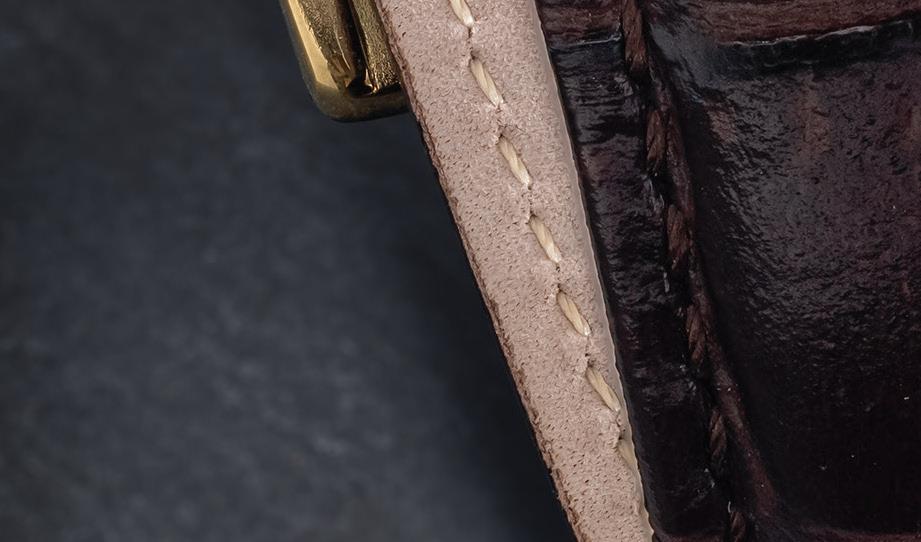
*Special price only for customers using the offer code.






“An elegant and exciting timepiece that every collector will love.”

— George Thomas, internationally renowned watch expert

“[A] unique and beautiful timepiece.”
— Carlos C., Los Banos, CA










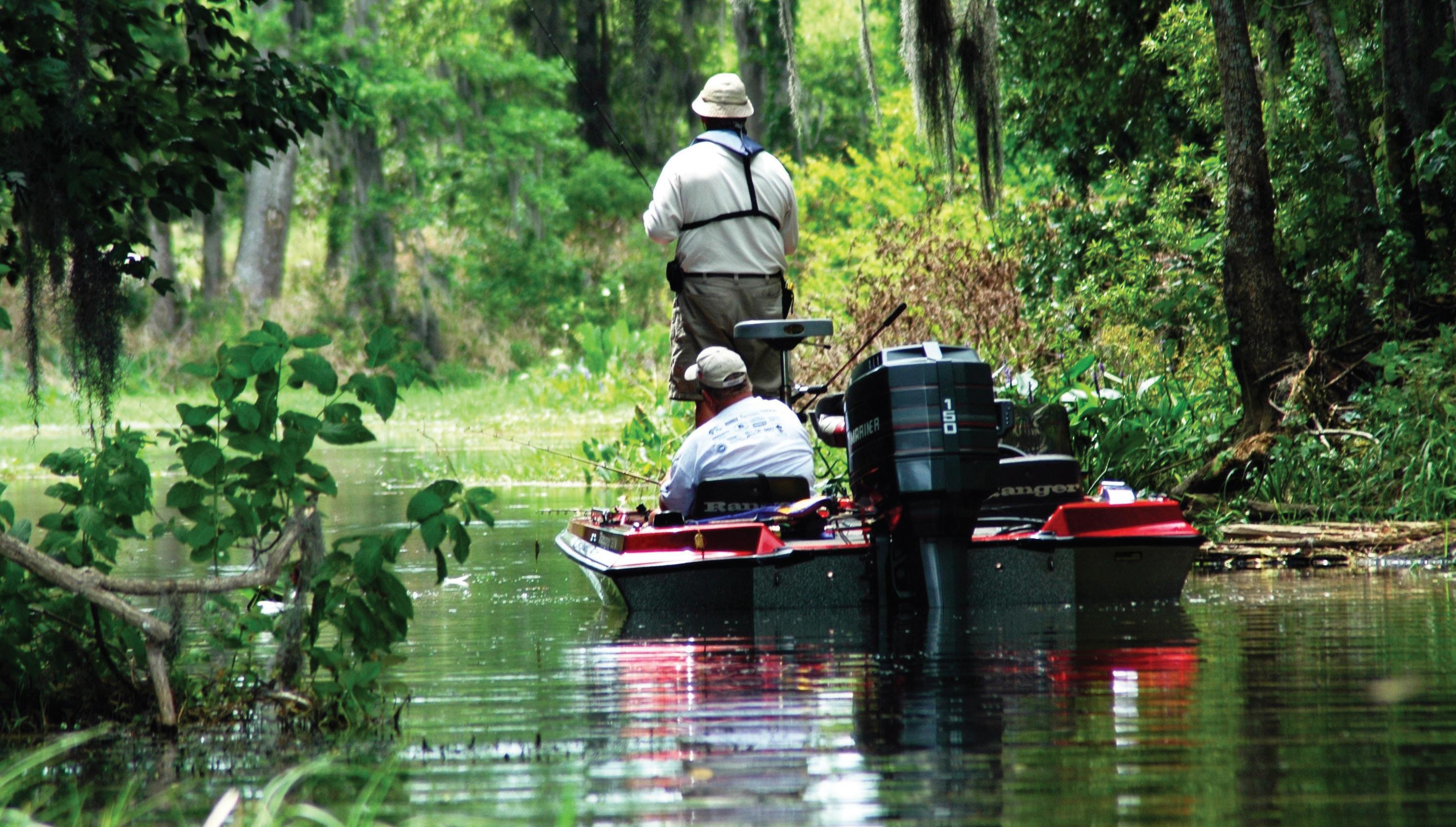

We scrutinize each patch of light-colored sand as we move slowly along the lake’s shoreline, looking for dark oblong objects hovering near the bottom.
In Florida, bass might start spawning as early as late December, depending on location and weather. The spawn continues into May, peaking during the full moons of February and March.
On a large system, bass could spawn at different times over several months, depending on local conditions.
When water warms sufficiently, male bass scour out saucershaped depressions on the bottom. Females later join the males in the nests. After spawning, females depart, leaving the males to guard the eggs and fry.
Bass commonly make beds on shallow flats or humps with hard gravel or sandy bottoms close to deeper water. Sometimes, they build nests on roots or other objects. They also like good cover near the bedding area.
Brush, vegetation, fallen trees or docks can provide overhead protection, giving bedding bass more security since they remain vulnerable to predators, such as birds, while guarding shallow beds.
With clear water so prevalent in many lakes and streams across the Sunshine State, the spawn also means “sight-fishing” season. Anglers frequently spot and catch huge bass on shallow beds. Before they can catch bucketmouths, though, anglers need to find them.
“Sight-fishing is like hunting,” says Shaw Grigsby, a professional bass angler from Gainesville. “The challenge is finding the fish. Once we find them, we can often get them to bite. Bass on the beds don’t feed, but they grab baits instinctively to protect their eggs and fry.”
For tempting bedding bass, anglers can use a variety of baits, but soft-plastic creatures probably work the best. The best lures mimic notorious nest raiders, such as salamanders, crawfish and small fish. Tubes, jigs, lizards, worms, craw-tail trailers and similar temptations work well for pulling lunker largemouths from their beds. Baits that imitate bluegills, another nest bandit, might also work.
Some people throw at one huge bass for several hours before it hits a bait or leaves. Bedding bass typically do not chase baits far or fast, so play it subtle. They reactively grab baits to kill anything that might harm the eggs or remove any debris that could interfere with the hatching.
“Most people get too close to the fish,” says Terry Scroggins, a professional bass angler from San Mateo. “If anglers can see the fish, the fish can see them. In clear water, fish may spook, so I back away and make long casts. Sometimes, I mark the bed with a tomato stake and come back to it.”
From a distance, toss a lure behind the nest and drag it into the bed. Leave it there motionless. Then, occasionally shake the rod. Any little subtle action could provoke a strike.
People can sight-fish for bass anywhere in Florida. The St. Johns system, Kissimmee or Harris chains, Lake Okeechobee and many other state waters make great places to catch lunker largemouths as winter turns to spring.

John N. Felsher is a freelance writer, broadcaster, photographer and editor. An avid sportsman, he’s written more than 3,500 articles for more than 170 different magazines on a wide variety of outdoor topics. He also hosts an outdoor tips show for WAVH-FM Talk 106.5 in Mobile, Alabama. Contact him at j.felsher@hotmail.com or through Facebook.




you can tell right away why we’re called “Stiltz”!
A Stiltz Homelift is 100% safe. The homelift will not operate when the door is open, and sensors stop the lift cab if something is in the way. A battery backup lowers the lift cab in a power outage.
Stairlifts were introduced in the 1920s, and not much has changed since. A stairlift has one use: to move you (and only you) between �loors, slowly. And it �its in only one place: your staircase. Finally, a stairlift won’t keep up with you as your mobility needs change over time. For example, a stairlift can’t carry a walker or wheelchair.
A Stiltz Homelift, on the other hand, is an affordable, modern Homelift that is so compact, it �its just about anywhere in your house. It requires no special machine room, no supporting walls, and runs off a standard home electrical outlet. One look at our unique free standing rail system, and

A Stiltz Homelift is versatile. Our homelifts carry two people, or even a wheelchair. And the small footprint means they �it just about anywhere. Install your homelift through the �loor, in a stairwell, up to a landing — even inside a closet!
A Stiltz Homelift is clean and quiet. Our self-contained electric drive system is very quiet. No messy hydraulics, no noisy vacuum systems, no machine rooms required.
A Stiltz Homelift is an extra pair of hands. Move laundry, suitcases, groceries and vacuum cleaners — up and down between �loors.
IT’S NEVER TOO SOON
Some Stiltz customers need a Homelift immediately. But others want to “future-proof” their homes for when the stairs become a challenge.
HOMELIFT SPECIALISTS
Stiltz is one of the world’s leading Homelift manufacturers, so you’ll be in good hands. Your homelift will be installed and maintained by Stiltz trained professionals — expert technicians who truly care about your freedom.
• Affordable
• Small Footprint
• Full Safety Features
• Clean, Quiet Operation
• Low Power Consumption
• Freestanding Design
• Wheelchair Accessible
• Carry Laundry or
• Fast Installation
• Full Warranty





All ages can find something new and exciting around every corner of the state. Filled with rich history, abundant natural beauty and diverse events all year, Florida has something fun for everyone.
February 2-4
Annual Krewe of St. Andrews Mardi Gras Festival

The Krewe of St. Andrews invites you to Beck Avenue for three days of parades, lots of beads, food, drinks, music and vendors. A children’s parade is Friday, followed by the main parade Saturday and a pet parade Sunday. Bring the whole family because there’s something for everyone. standrewsmardigras.com; kosapcfl@gmail.com
February 8-10
Annual Fundraiser Variety Show and Silent Auction
Celebrate Marathon Community Theatre’s 80th birthday at this annual event. This fundraiser begins each night at 5 p.m. Actors, dancers and singers hit the stage at 7 p.m. to entertain and honor MCT’s history. Enjoy a complimentary smorgasbord and a free champagne toast after the curtain falls at 9 p.m. Tickets for the show are $45. marathontheater.org; 305-743-0408

January 27
Riverside Market
Making its debut in 2023, this market is making traction. Running every third Saturday, the market introduces the community to small local vendors and raises funds to invest in the community. Live music, food trucks and more are added to the market as it grows along the river at 299 Riverside Drive. www.facebook.com/RiversideMarket; 954-358-8333

February 10

37th Annual Civilian Conservation Corps Festival
The annual festival begins at 10 a.m. at Highlands Hammock State Park. This is the park’s signature event and showcases the park by celebrating history, art, nature and music. The festival includes guest speaker Gary Mormino, Florida Artist Blacksmith Association artisans, a silent auction, heritage demonstrators and a Cow Camp Reenactment by the Lake Kissimmee State Park.
floridastateparks.org/park/highlands-hammock; 850-245-2157
February 12-13
Florida Keys Concert Series
The Balourdet String Quartet is an energetic ensemble on a meteoric rise. Based in Boston, the young prize-winning group is in residence at the New England Conservatory’s Professional String Quartet Program. It is as exciting to watch as it is to hear. Concerts start at 7:30 p.m. in the Marathon High School auditorium. www.floridakeysconcerts.com; 800-324-6982







February 15
Nashville Live
Dave and Daphne are a dynamic duo who do it all. Their music includes classic country, Broadway, pop, Southern gospel, jazz and bluegrass. They perform at 7 p.m. at the South Lake Wales Church of God, 210 Presidents Drive. Tickets are $15. www.slwcog.com; 813-779-2174
February 17
Garden Walk
The Garden Club of the Upper Keys invites you to attend a garden walk from 10 a.m. to 4 p.m., rain or shine. Tickets are available online. Complimentary clubhouse activities include food trucks, vendors, artisans and shopping for plants. An art show is sponsored by the Art Guild of the Purple Isles. www.gardenclubupperkeys.org; 786-752-6562


February 19-20
Florida Keys Concert Series
Trio Con Brio Copenhagen consists of the Danish pianist Elvekjaer and South Korean sisters Soo-Jin Hong (violin) and Soo-Kyung Hong (cello). Recognized as one of the finest piano ensembles, they are touring artists, esteemed recording artists, artistic directors and educators. Concerts start at 7:30 p.m. in the Marathon High School auditorium. www.floridakeysconcerts.com; 800-324-6982
February 24
Florida River Fest
This festival is held in the heart of the Florida Panhandle at Neal Landing and highlights the river region with vendors, live entertainment and family fun. Gates open at 10 a.m. CST. Activities include Touch A Truck, live entertainment, a children’s zone and the River Dig. Shop nearly 100 vendors from across the Southeast or watch the boat parade. The entrance fee is $5 (cash only) at the gate. Children 5 and younger enter for free. In the evening, head to Bowles Field for the Rock the River Concert at 4:30 p.m., featuring Kendall Tucker, Dylan Kelley and Colt Ford. www.riverfestfl.com
February 24
Sombrero Beach Run


February 24

Orange Blossom Festival Rodeo

The Key West Southernmost Runners Club welcomes you to the 15th annual Sombrero Beach Run. This is the No. 1 running event of its kind in the Florida Keys. Kick off Friday night with a registration party at Sombrero Beach. Race day, be swept away with entertainment by DJ Tito, runners breakfast, after-race lunch, drinks, ice cold beer, custom T-shirts and raffles. Sunday activities include kayaking, barbecue and games. www.sombrerobeachrun.org; 305-743-4582
February 26-27
Florida Keys Concert Series
Each year, the series tries to highlight future stars of the classical music world. This year’s rising star is pianist Eric Lu, who won first prize at The Leeds International Piano Competition in 2018 at age 20. The following year, he signed an exclusive contract with Warner Classics and has since collaborated with some of the world’s most prestigious orchestras. Concerts start at 7:30 p.m. in the Marathon High School auditorium. www.floridakeysconcerts.com; 800-324-6982



A south Florida tradition now in it’s 87th year, the Orange Blossom Festival includes a parade, professional rodeo and other family activities. The rodeo is produced by the Weekley Brothers Davie Pro Rodeo and includes bull riding. www.davieprorodeo.org; 754-816-3183


Want to share a family-friendly event with the readers of Florida Currents? Enter the details at tinyurl.com/FloridaCurrents. Make sure to submit the item at least 60 days before the event (due to press deadline). If you own rights to a print-quality photo promoting your event—perhaps from a past year— include it with photo credit information.


Florida has more than 200 species of butterflies, some of which cannot be found anywhere else on Earth.
To attract these delicate creatures, your butterfly garden must provide food for the adult butterflies and their caterpillars. Though many butterflies will drink nectar from a variety of flowering plants, caterpillars are often limited as to which plants they can feed on.
Major Components of a Successful Butterfly Garden
• Adult nectar sources: attract and nourish adult butterflies.
• Larval host plants: attract ovipositing female butterflies and serve as a food source for developing larvae.
• Shelter: vegetation that provides protection from temperature extremes, storms/rain and predators, as well as locations for roosting/sleeping.
• Water source with fountain: allows for easy and consistent access to water for drinking and thermoregulation.
Garden Design
• Provide a combination of adult nectar sources and larval host plants. This attracts a variety of butterfly species; encourages butterflies to remain in your yard, reproduce and build populations instead of just passing through; and allows the gardener to appreciate all butterfly life stages.
• Incorporate native plants into the landscape whenever possible. Most larval host plants are natives. They’re adapted to the region, will produce a small but representative extension of the natural ecosystem and can attract other wildlife.
• Create horizontal and vertical diversity. Choosing plants that have different heights and growth habits creates numerous microclimates, which in turn appeal to a greater diversity of butterfly species, provides shelter and creates levels of feeding opportunities.
• Aim for a consistent host plant and floral venue throughout the growing season. Choose plants that have different blooming times. This ensures the garden remains attractive and productive as long as possible, and it provides food for butterflies during periods of low natural availability.
• Provide a number of different flower colors. Different butterfly species are attracted to different flower colors, so include yellow, orange, white, blue, red, pink and purple flowers.
• Provide a mix of flower shapes. The feeding behavior and proboscis length of a butterfly dictates which flowers will be visited. For example, long-tubed flowers are typically more accessible to species with long proboscis, whereas many composites (daisy-like flowers) provide a feeding platform and easy nectar accessibility for smaller species.
• Plant in shade as well as full sun. This appeals to more butterfly species. Many forest species prefer shadier locations.

• Plant in groupings. Groupings are aesthetically pleasing and provide masses of color. They are more apparent in landscape and allow larvae to locate additional food resources in a shortage.
• Choose appropriate plants for each location. Understand each plant’s basic water, light, and soil requirements so it can perform and grow to its maximum potential.
Select plants suitable for your landscape, and use pesticides carefully to avoid harming butterflies and other beneficial insects.
• Give new plants a good start: Water and mulch new plantings to ensure establishment.
• Fertilize: A regular fertilizing regimen will produce maximum growth and flower production.
• Avoid pesticide application when possible: All butterfly life history stages are sensitive to pesticides. Avoid Bacillus thuringiensis, and when a pest problem arises, treat it locally. Use beneficial insects/natural enemies.
• Learn to identify the butterfly species in your garden: This provides greater enjoyment and allows for the gardener to plant for particular local species.
The most obvious benefit of butterfly gardening is that it attracts wildlife, bringing butterflies and more into your garden for purposes of enjoyment, observation, study and photography.
However, there’s another important reason: ecosystem and habitat conservation.
A well-planned butterfly garden becomes a small but representative sample of the surrounding habitat and as such provides a haven for butterflies and other wildlife to gather, seek shelter, acquire food and water, reproduce, and build populations. Do not underestimate the importance of even a small garden.
Don’t discount the therapeutic benefits. Butterfly gardens provide a soothing retreat from everyday life. If you use herbs to attract butterflies, you’ll have the bonus of aromatherapy. n

Natasha Atlas graduated from the University of Florida’s Agricultural Education and Communication Program in 2021. Natasha loves writing about unique and new varieties of flowers and plants for the Neighborhood Gardener Newsletter and its 10,000 subscribers. When she isn’t writing, she enjoys tending her own garden on her balcony
Horse barn with five stalls, paddock and about 4 acres of pasture in Wewahitchka, one block from the old courthouse. Lease by the stall, with discount for multiple horses. 740-334-0341.
12 acres coastal Bermuda pasture. Irrigation available. 850-814-7015 or 850-814-6078.
Miniature donkeys. Jacks and jennies; black, brown, gray and paints. All ages. $300 and up. Make great pets. Also, standard donkeys. Betty, 850-899-7424.
ABGA 100% traditional Boer goats. All ages; bucks and does. Please leave message if no answer. 850-849-2426.
Two prepaid double cemetery niches at Forest Lawn on Highway 231. 850-876-0580.
2005 Honda 1800 Goldwing electric start motorcycle. Harbor Blue, new tire, new brakes. Runs great. 50,000 miles. Asking $5,500. 850-814-6009.
2006 Pontiac Vibe. Good, dependable car. 30 miles per gallon. 166,285 miles (less than 10,000 miles per year). $6,000. 850-381-3451.
Approximately 200 pieces of milk glass and miscellaneous jewelry and two jewelry stands. Come see and make an offer. 850-730-4089.
Three-bedroom, two-bath home on 1-acre lot on the Choctawhatchee River at Cedar Log Boat Ramp, 80 Old Creek Road, Ponce de Leon, FL 32455. Wayne, 850-373-7944; or Jason, 850-258-1085.
2.5 acres lakefront on Deerpoint Lake, 30 to 45 minutes from Panama City. Paved road, electricity, septic, close to schools, quiet and peaceful. Can be divided. Asking $299,900. 850-265-5554.
Half-acre corner lot. 850-639-2220.
FSBO: Two adjacent lots, about 2.5 acres on paved road, 10 miles north of Wewahitchka, 45 minutes from beaches. Border the Chipola River and Cypress Creek. Cleared and ready to build. Quiet and peaceful; no neighbors. Deeded restrictions. Underground utilities, deep well, many fruit trees. $69,900. 850-648-4214.
Kapua Kleans for your final interior cleanup, deep clean, residential, condo, rental property. Steph, 850-704-2412.
Rachel’s Facials, Lashes and Brows, located at 2918C Highway 77 in Lynn Haven. Florida licensed esthetician for facial and skincare services, including eyelash extensions, simple waxing, brow shaping and tinting, and makeup services. 850-896-4855.
WJ Land Management. Florida licensed and insured. Forestry mulching, land clearing, culverts, fencing. Fast, free and reliable estimates. William, 850-628-4714; or Tabatha, 850-628-4713.
SLR Farm & Landscaping. Lawn care, grass cutting, bush hogging, backhoe work. 706-575-4570 or 850-703-5321.
Carter’s Land Clearing and Mulching LLC. 850-527-4715.
Hamco Business Solutions is conveniently located in downtown Panama City with our warehouse in Lynn Haven. We offer hundreds of products at discounted prices including POS paper, ink cartridges, deli paper, kitchen paper and copy paper. We have free, same-day delivery on most products. Shop local and save.
Handyman services. Painting, flooring, building repair, odds and ends. Free estimates and fully insured. TJ, 207-612-8255 or 207-578-1830.
Tree Be Gone. For all your tree needs, from trimming to complete removal. 850-819-9987.
Merchant Management Group is a local payments technology company based in Panama City, working with quick-service restaurants, full-service restaurants and retail shops and specializing in the latest point-of-sale systems including Tabit, OrderCounter and Clover. Have worked with hundreds of Gulf Coast businesses since 2004 and have an A+ rating with the BBB. Schedule your demo, 850-747-0664.
Wanted
14” and 15” utility trailer rims. Need approximately one dozen of each. Can be a little rusty because they will be painted. Standard lug pattern (5 on 4½). I will pay $10 each. 850-303-1460.
Towing straps for rafting. Text only, 850-257-3056.
Trading Post is a FREE service to Gulf Coast Electric Cooperative members. GCEC reserves the right to edit or reject ads. PLEASE PRINT LEGIBLY OR TYPE.
Please circle the category that applies: For Rent For Sale Real Estate Free Miscellaneous Trade Wanted
Items:
Name: Phone:
Address:
Mail your ad to: The Trading Post; Gulf Coast Electric Cooperative; 9434 Highway 77; Southport, FL 32409; return with your electric payment; or email ad information to tradingpost@gcec.com.
** Due to press deadlines, please expect up to 60 days from submission for your advertisement to appear.

As winter’s icy grip tightens, many turn to space heaters for a quick burst of warmth. These handy appliances can be lifesavers but pose potential safety hazards if not used properly.
To ensure a cozy and fire-free season, follow these essential space heater safety tips.
• Maintain a 3-foot fireproof zone around your heater by keeping it away from curtains, furniture, bedding and even papers.
• Place your heater on a level, flat surface, away from anything that could tip it over. Avoid tables, counters and carpets.
• Don’t overload outlets. Plug your heater directly into a wall outlet. Do not use extension cords or adapters.
• Choose a heater certified by a well-known testing organization like UL or CSA.
• Buy a heater with an automatic shut-off feature for if it tips over.
• Look for a model with overheating protection to reduce fire hazard.
• Never leave your heater unattended. Turn off and unplug it when you leave the room or sleep.
• Keep children and pets away to avoid burns or accidental tipping.
• Don’t hang clothes or towels on your heater to dry.
• Clean your heater according to the manufacturer’s instructions to prevent dust buildup and ensure proper airflow.
• Install multiple smoke detectors, especially in or near bedrooms.
Follow these simple tips to enjoy warmth and comfort without compromising safety. n








Dear Student:
Gulf Coast Electric Cooperative is proud to offer an exciting opportunity for high school seniors in its service area: the chance to win a $1,000 scholarship!
We have made two changes to our scholarship program since last year:
1. The drawing will still be random. However, it will not occur “live” during our Annual Meeting. Winners will be randomly selected and notified on Friday, April 26, 2024. To receive a scholarship, you must agree to attend our 76th Annual Members’ Meeting on Saturday, April 27, at our office headquarters in Wewahitchka. The winners will be recognized during the program.
2. We have increased the number of $1,000 awards from 10 to 20!
High school seniors graduating at the end of the 2023-2024 school year including homeschooled students whose parents or guardians are members of GCEC and who are attending a college, university or technical school for the Fall 2024 semester are eligible to enter the drawing.
Upon proof of enrollment in a college, university or technical school, scholarship checks will be made payable to the college, university or technical school for first-semester expenses.
To enter, eligible students will need to complete the GCEC 2024 Scholarship Application and submit it to the co-op by the deadline of Friday, March 29.
If you or your parent/guardian have any questions, please call me at 850-913-3731 or email kdouglas@gcec.com.
Sincerely,

Kristin Douglas Vice President of Marketing and Communications
Please read letter on opposite page for qualifications/terms before applying.
Student Name:
Parent/Guardian: GCEC Account Number:
Address:
City/State/Zip:
Telephone No.: Email Address:
Education Information
High School: GPA:
College/Technical School (attending fall 2024):
Major (if known):
List all unpaid volunteer community service activities in which you have been involved that have improved your community and/or made a difference in the lives of others. Include all service activities you have participated in to help your school, friends, church and community. Use additional sheets of paper, if necessary. Include your name at the top of each additional page.
Student Signature:
Parent/Guardian Signature:
By you and your parent/guardian signing this application, you are certifying that the information you have provided is true and complete to the best of your knowledge. In addition, you are authorizing GCEC to release your name, photo and educational information if you are selected as a winner.
Applications are due no later than Friday, March 29, 2024, to:
Gulf Coast Electric Cooperative, Attention: Kristin Douglas, 9434 Highway 77, Panama City, FL 32409 For more information, email kdouglas@gcec.com or call 850-913-3731 (fax 850-265-3634).
Romance should be a daily event. Of course, it’s nice to make a special day to shower your partner with gifts and a date on Valentine’s Day, but romance can easily be forgetten the other 364 days of the year.
Daily romance has you diving further into what makes your partner tick. Gifts then take the form of words, cleaning, tiny adventures, a coffee or a simple song.
Here are a few ideas to consider while keeping the love alive throughout the year:
• Shower your partner with compliments or thank-yous for things they do around the house or for you. Never underestimate a thank-you, even for the small things.
• Tiny adventures are a way to get out of the house without spending a lot of money. Find a nearby trail to hike; pack a picnic to take to the park; visit a bookshop and choose a book for each other; or take a day to experience a free museum.
• Are they a coffee or tea lover? Make them a random cuppa when you see they need a little pick-me-up.
• Speaking of needing a pick-me-up, if you see your partner is having a rough day or maybe a rainy day has brought them down,

throw on a song you know will make them smile.
Gifts don’t always need to be material. Sending someone a song in the middle of the day or leaving them a note by the front door goes miles in showing how much you care.



Amemorable
beach moment: You’re basking in the warm sun, toes in the sand, letting the gentle turn of the foam-capped waves lull you into a state of complete relaxation. As your eyes scan the endless horizon of blue on blue, you’re rewarded with a pod of dolphins making their way across the sea.
There’s no denying their signature shape as they leap from the water. If you don’t see anything else extraordinary the rest of day, you can take solace knowing you’ve witnessed one of nature’s most playful and human-like creatures in their natural habitat.

Why not re-create that special moment with our Balinese Dolphin Pendant? We’ve captured two dolphins midjump in sterling silver crafted in the Balinese style. Tucked between these beloved sea mammals is a full carat of shimmering blue topaz. Made by some of Indonesia’s finest artisans, this pendant is an absolute steal at JUST $29! That’s what we call our Stauer IMPOSSIBLE PRICE!
Nothing captures the shimmering color of the ocean in the midday sun like blue topaz. With its sparkling, clear blue color and high reflective index, blue topaz is one of the world’s top-selling gemstones. The Gemological Institute of America lauds topaz for its hardness, noting that blue topaz is known for its intense color that’s better than aquamarine. With this special price, you can score quite the catch.


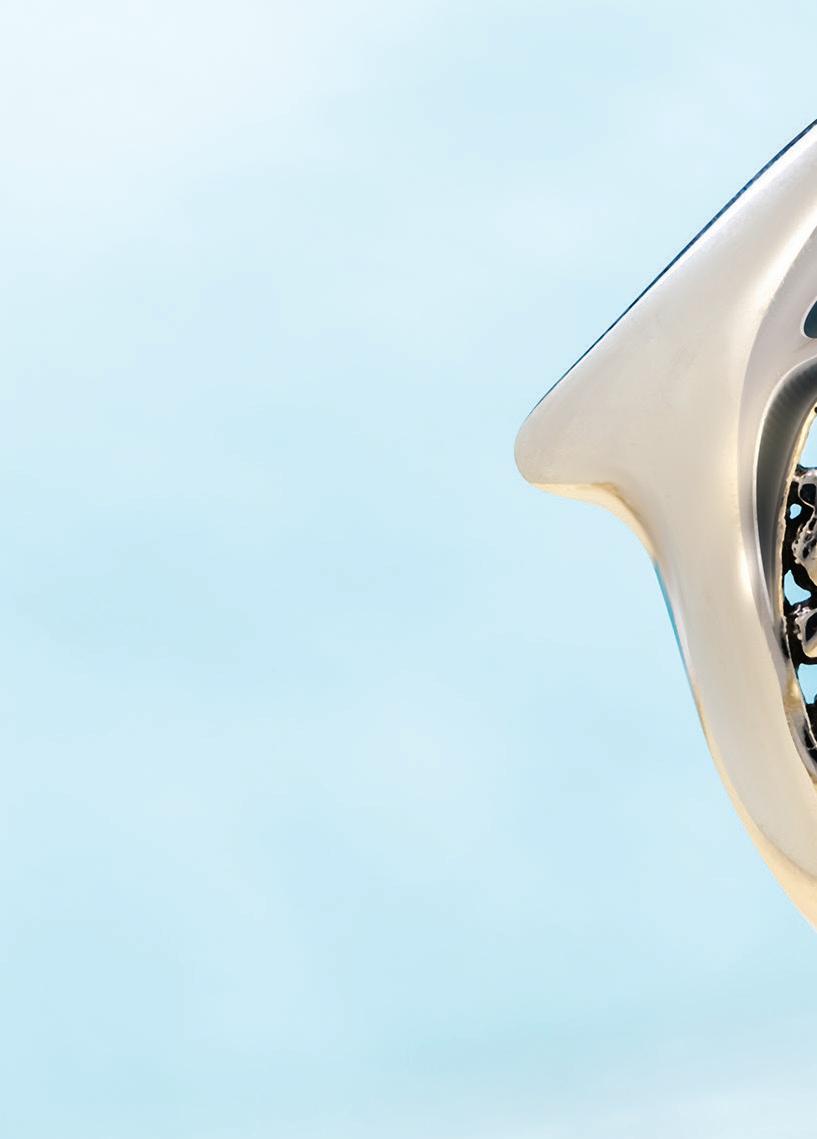
Satisfaction guaranteed or your money back. Enjoy the Balinese Dolphin Pendant for 30 days. If it doesn’t pass the test swimmingly, send it back for a full refund of the item price.
Limited reserves. This pendant is already one of our best sellers this year. A full carat of genuine blue topaz set in .925 sterling silver for this price is as rare as a dolphin sighting. We cannot guarantee availability for long. Call today! This offer is limited to the first 1,900 responders to this ad!
Jewelry Specifications:
• Made in Indonesia
• Blue topaz and .925 sterling silver
Balinese Dolphin Pendant (1 carat)
$299 $29* + S&P Save $270
*Special price only for customers using the offer code.





One carat of shimmering blue topaz set in sterling silver for only $29

What Stauer Clients Are Saying About Our Topaz
“Just lovely! Would recommend it as a purchase. Thank you STAUER.” — Mary L.




Offices
722 W. Highway 22
P.O. Box 220
Wewahitchka, FL 32465
850-639-2216 or 800-333-9392
9434 Highway 77 Southport, FL 32409
850-265-3631
Outages: 800-568-3667
6243 E. Highway 98 Panama City, FL 32404
850-481-1188
www.gcec.com
ceO/General ManaGer
John Bartley
TrusTees
President Jimmy Black
Vice President Carl Goodson
Secretary Betty Moore
Treasurer Doug Birmingham
Rupert Brown
Robert Byrd
Kinneth Daniels
Eddie Jones
Dwight Van Lierop
Trustees normally meet the third Tuesday each month at 12:30 p.m. CST.
The mission of GCEC: Fulfilling the changing needs of our membership and communities by providing costeffective, reliable and safe utility services through a dedicated and responsive workforce.
Power lines. They deliver electricity to homes and businesses and are essential to our modern way of life. We see them everywhere, so we sometimes forget they can be potentially dangerous. Myths abound when it comes to power line safety. To help protect our communities, Gulf Coast Electric Cooperative believes it’s crucial to end power line misconceptions.
Myth 1: I’m safe as long as I don’t touch power lines.
One of the most common myths about power lines is the belief that you’re safe as long as you don’t physically contact them. Power lines can energize the air around them. If you get too close, electricity can arc (jump) to you, leading to possible injury or death. Therefore, stay far away from power lines.

Myth 2: If birds can sit on power lines, it’s safe for humans.
Birds often perch on power lines without harm. Since there is no difference in voltage in the short distance between a bird’s feet, no circuit is created, and no electricity flows through its body. However, an electric shock occurs if a person touches a power line while touching the ground or another conductor.
Myth 3: Wooden ladders are safe around power lines.
Some believe using a wooden ladder protects them when working near power lines. Wood is not a sufficient insulator when it comes to electricity. Only use nonconductive ladders around power lines and maintain a safe distance from them.
Myth 4: It’s safe to trim trees near power lines.
Trimming trees near power lines should only be performed by trained professionals. The risk is too great for anyone else. Falling branches could strike power lines and you at the same time, causing physical harm or death.
Myth 5: Power lines are insulated, so they’re safe to touch.
Power lines are typically not insulated with a protective covering like household wiring. Touching a power line, even if it appears insulated, can deliver an electric shock. Always assume that power lines are energized and avoid any contact.
Understanding power line safety helps prevent accidents and protect lives. GCEC promotes a culture of awareness and safety by encouraging everyone to play it safe with electricity.